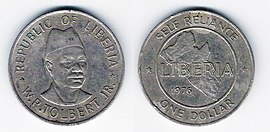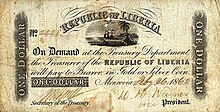Liberian dollar
| Liberian dollar | |
|---|---|
| Country: |
|
| Subdivision: | 100 cents |
| ISO 4217 code : | LRD |
| Abbreviation: | Lib $ |
|
Exchange rate : (29 Mar 2020) |
1 EUR = 219.999 LRD 1 CHF = 204.65 LRD |
The Liberian Dollar is the currency of the Republic of Liberia in West Africa . It is divided into 100 cents . The ISO code is LRD.
background
Liberia was founded as a state for former slaves from the USA . Therefore, the American dollar was also adopted for Liberia. In addition to the Liberian dollar, it is also used today as a means of payment.
Banknotes exist in denominations of LRD 5, 10, 20, 50, 100 and 500. The presidents of Liberia are shown:
- 5 LRD: Edward J. Roye , 5th President, led Liberia into national bankruptcy and was assassinated
- 10 LRD: Joseph Jenkins Roberts , 1st President
- 20 LRD: William S. Tubman , 1944–1971, as a member of the “American” upper class, treated the natives like slaves
- 50 LRD: Samuel K. Doe , 1980–1990, was the first to come from not the upper class, but the Krahn (people) ; murdered his predecessor Tolberts and started the Liberian Civil War
- 100 LRD: William R. Tolbert junior , 1971–1980, in his day the contradictions that arose under his predecessor Tubman turned into violence
The currency is administered by the Central Bank of Liberia .
Monetary history
The Liberian coins and banknotes were made in the US state mint from the start. Until Liberia's declaration of independence , the coins were labeled American Colonization Society , the first set of coins was minted with the consent of the US government in 1833, a total of 64 editions have appeared so far. Paper money was issued for larger amounts . The equivalent was kept in the state office in Monrovia .
Today (2019) the coins have disappeared in daily money transactions. Banknotes over 100, 50 and 20 dollars are widespread, notes of 500 dollars are also rarely found. The prices in shops are - at least in the capital Monrovia - mostly in US $, but in many shops you can also pay with the Liberian dollar.
Commemorative coins
Liberia (like Somalia , the Cook Islands , Nauru , Niue , Palau and a few other small states) is known for the fact that a particularly large number of commemorative coins from this state are offered on the European coin market. However, many of the motifs that were coined have absolutely no relation to the country (e.g. the Gorch Fock or the fall of the Berlin Wall ). They are produced by German companies in Germany or elsewhere (but not in the issuing country) and upon payment of a license fee to the respective government, they are given the character of an official means of payment and thus formally a coin , in contrast to other private mintings, which are medals . Nevertheless, these coins are treated like medals on the coin market, as the company in question can issue as many different coins as it wants and therefore has no numismatic value. The resale value of such pseudo coins on the coin market is therefore the pure metal value. That is why they are not traded in coin dealers; The main sales channels are newspaper advertisements and teleshopping , where attempts are made to sell unsuspecting customers supposedly rarities at significantly inflated prices.
Web links
- Liberia Silver and Copper Coin Set (1906) - New York Public Library Archive Photo Collection
- Central Bank of Liberia (English WP)
Individual evidence
- ↑ a b c d Frank Stocker: Liberia: When slaves keep slaves . Frankfurter Allgemeine Sonntagszeitung , March 9, 2014
- ↑ Tim Ziebarth: Foreign Coins Struck at US Mints-werk = The Willamette Coin Club ( Memento from July 4, 2008 in the Internet Archive )
- ^ Liberia Exhibition. In: The Library of Congress (website of the US State Archives). Retrieved December 6, 2010 . (English)
- ↑ Information on alleged commemorative coin issues from Liberia and other small states ( Memento from December 7, 2013 in the Internet Archive )

